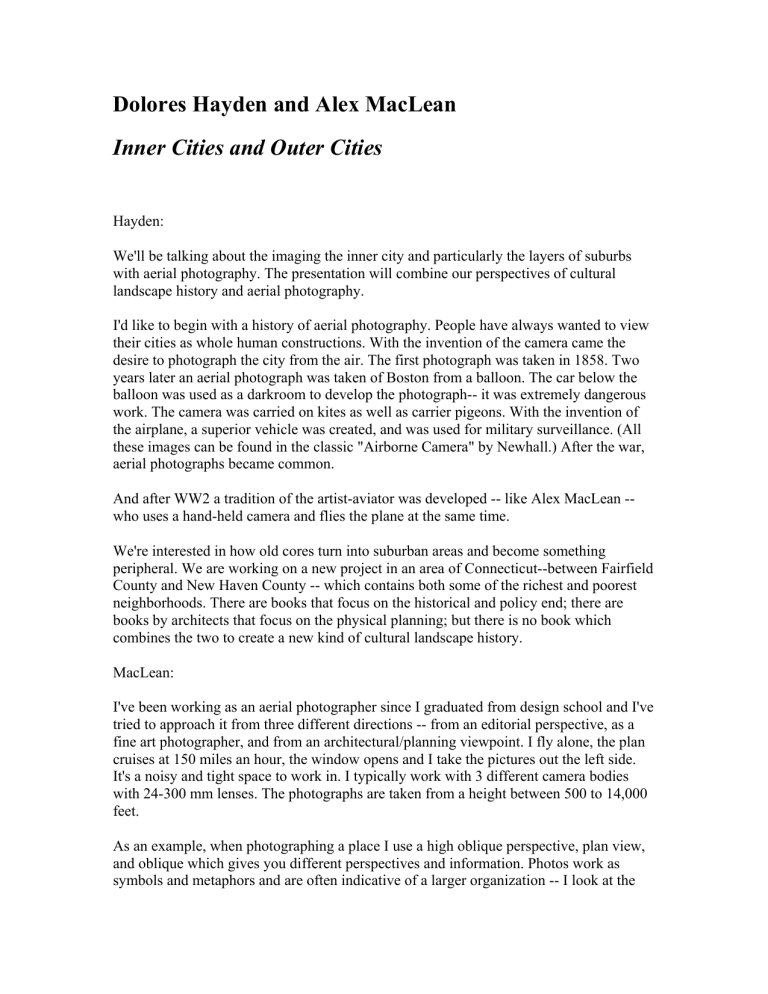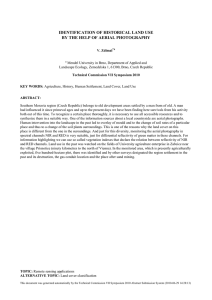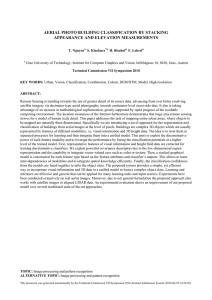Dolores Hayden and Alex MacLean Inner Cities and Outer Cities

Dolores Hayden and Alex MacLean
Inner Cities and Outer Cities
Hayden:
We'll be talking about the imaging the inner city and particularly the layers of suburbs with aerial photography. The presentation will combine our perspectives of cultural landscape history and aerial photography.
I'd like to begin with a history of aerial photography. People have always wanted to view their cities as whole human constructions. With the invention of the camera came the desire to photograph the city from the air. The first photograph was taken in 1858. Two years later an aerial photograph was taken of Boston from a balloon. The car below the balloon was used as a darkroom to develop the photograph-- it was extremely dangerous work. The camera was carried on kites as well as carrier pigeons. With the invention of the airplane, a superior vehicle was created, and was used for military surveillance. (All these images can be found in the classic "Airborne Camera" by Newhall.) After the war, aerial photographs became common.
And after WW2 a tradition of the artist-aviator was developed -- like Alex MacLean -- who uses a hand-held camera and flies the plane at the same time.
We're interested in how old cores turn into suburban areas and become something peripheral. We are working on a new project in an area of Connecticut--between Fairfield
County and New Haven County -- which contains both some of the richest and poorest neighborhoods. There are books that focus on the historical and policy end; there are books by architects that focus on the physical planning; but there is no book which combines the two to create a new kind of cultural landscape history.
MacLean:
I've been working as an aerial photographer since I graduated from design school and I've tried to approach it from three different directions -- from an editorial perspective, as a fine art photographer, and from an architectural/planning viewpoint. I fly alone, the plan cruises at 150 miles an hour, the window opens and I take the pictures out the left side.
It's a noisy and tight space to work in. I typically work with 3 different camera bodies with 24-300 mm lenses. The photographs are taken from a height between 500 to 14,000 feet.
As an example, when photographing a place I use a high oblique perspective, plan view, and oblique which gives you different perspectives and information. Photos work as symbols and metaphors and are often indicative of a larger organization -- I look at the
built and natural environment as a series of pathways and containment. Within an image are a number of symbols which are almost subliminal, such as the image of a small New
England town.
Hayden:
The camera can tell powerful stories about the production of space with the camera, but we want to combine them with cultural history. I've developed a 5-part typology of suburbia. The five parts are chronological and they're physical, but they're all still with us. We don't lose the early ones.
1) The borderland starts around 1820. These are places where individuals took their families out of the urban realm to do something specific. They are guided by two sets of books -- books by Andrew Jackson Downing and Catherine Beecher. These books are appearing in the 1840s and are about how to cultivate a new type of lifestyle -- family by family.
2) Picturesque enclave: These are places where groups have hired an architect to design their new community in the borderlands. They are more communal. What is important is that they focused on community building. Other examples are the Methodists campgrounds, and the communitarian socialists. These are largely elite communities and these ideas became mass produced creating the suburbs.
3) Suburban typology: Public transportation helped create these places. With them came some mail order houses in addition to the triple-deckers. They density was quite high.
4) Single-family mass produced automobile suburb: Levittown is the most familiar example. This typology generates the fifth type...
5) Edge sprawl: is located near the freeway, but it includes single family plus commercial plus multifamily housing.
Most important of all is that the fascination began with the landscape and then focused exclusively on the house. The house is idealized, not the block, neighborhood, or the community.
Hayden and MacLean:
The next set of slides will show the area where we are now working...
The photos show mixed signs -- it's not always clear if a community is on its way up or down. One of our case studies is Guilford, a town of 21,000 people, an area with 4
national registered districts and a tendency towards edge sprawl. It's a borderland aesthetic, plus resort communities. It's restricted growth by having no sewerage system or public transportation system, but pressure to develop it has created edge sprawl.
We've shown material of our project as we're progressing and we'd like to conclude with a quote from the New York Times and which makes us ask if the "dreams of fields" is strong enough to hang on to the patterns which suggest the borderlands and picturesque enclave.
Questions, Answers, Comments
Q: Some of the images you showed of a suburban home which had excessive roadway widths and cul-de-sac standards -- by any measure today, these spaces are way more than standards requires. My hypothesis is that the members on the Guilford planning board who review them actually think that if they say that much space is needed, they'll get fewer homes and less development. I call it malignant naiveté. Do you know if the zone rules in that town mandate it and do you know why an alternative isn't used?
A: We're just starting discussions why it is this way and it's very confusing. I don't know why that is. The new urbanism hasn't reached them yet.
A: I'm on the planning board in Lincoln and we have ridiculous standards too. The usual strategy is to use it as a bargaining chip with the developers to get concessions.
C: In Minneapolis, planners say they'd like the tighter standards, but the fire department runs in and says safety.
C: Not all communities are the same. Not all have the same knowledge and aren't aware of the state of current good practice.
Q: Have you seen changes in the landscape over the years you've been photographing?
What is the change?
A: The changes have been dramatic in the last ten years. Six or seven years ago, you heard that "big box" stores were coming to New England. Seven to eight years ago, threecar garages were not the standard -- they are today. But landscapes do change in small increments that people are often not aware of.
C: Other examples of similar images come from "Fractured Metropolis." They're very useful for helping communities visualize. There has been an emphasis on the seductive image, and I hope the work doesn't fall into focusing on the beautiful image. We also need overlays that aren't visible -- jobs, employment, income inequity, etc. Otherwise you preserve Guilford as a white elite place.
A: I agree completely. But this area is approximately 98% white -- there has been a long process of segregation and separation in this area. And the attitudes are pretty complicated. One of the most helpful tools is using ArcView software with the town's databases and overlay this information.
Q: You ended the presentation with three different scenarios. To what extent will the 5part typology help answer which scenario will become more prominent. And what is the causality for the shift from one typology to another?
A: The typologies previously developed were based on transportation patterns, not usually by class, or size of lot. There are a few exceptions -- Sam's book focuses on transportation, but it emphasized class. No one has done a good cultural history of suburbia.
C: My sense is that the single family home persists because it's seen as offering control and autonomy in a chaotic environment.
Q: If you gave this presentation to a group of people who lived there, what do you think their questions would be like? Viewing the landscape from high up, the deficits are clear, but on the ground deficits aren't so clear.
C: I used to live in Bradford, which is the town over from Guildford, and I lived in those houses that we viewed with some disdain. What I remember was that growth management was not a big deal. There may have been some pangs of regret, but mostly it was not of shock or dismay.
A: I was in a meeting the other day about restrictions on large houses in our community and it is interesting how threatened people feel about restrictions on their property and the general level of contentment about their own property. They focus on the home, not the community. It's a question of property rights. And yes, there would be a major shift in the discussion if the audience came from these areas.
A: We aren't trying to pick on one income group in particular. We may not like the building, but we don't dislike the people inside them. We think there should be more choices. We don't want to get into name-calling which is so prevalent in the literature or criticizing without looking at the positive side. We don't want to vilify suburbs or the city.
C: We value some patterns and we need to ask who does the valuing.
Q: Alex, how do you work as an aerial photography when you work for clients like developers? How do you mitigate conflicts?
A: It can be a problem. One way I rationalize it is that I own the copyright and everyone who wants to oppose the development can also use them. It is a conflict.
C: One of the best version of the psyche of the home was in "Independence Day" by
Richard Ford.
C: And I use it in my class, along with "The Man Who Loved Levittown" and "Typical
American."
Eran Ben-Joseph, real-time rapporteur
I'd like to bring some of the discussion back to the topic of Imaging the City. And I'd like to talk about aerial photography and perception. What is it about this view that makes it so different and what does it do to our collective consciousness? And what is it about the images of the suburbs and places that seem so different. One answer is that it offers a clarity of organization (or lack of organization).
I was reminded of the classic book "The Aircraft" (The Airplane Accuses" in French) by
Corbusier. Let me read you what Corbusier says... "The airplane indicts the city. It scrutinizes and gets to the heart of the cruel reality. The airplane insists on a new consciousness, a modern consciousness. Cities with their misery must be torn down and fresh cities built. The airplane gives us proof of the rightness of our desire to alter methods of architecture and town planning. It is a new standard of measurement. It is the basis of new sensation."
Is it the birds eye view that has changed our modus operandi? Aerial views have turned into powerful tools. The aerial view with its analytical scope has become a logical agent in the search for the utopian dream. Yet it also engenders a feeling of humility and respect. It can reinforce the interdependency between the human and natural world. It can affect our cultural imagination and action and let us hope that in another 65 years we will be spared the anguish over the images of our urban built environment.



